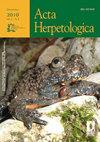齿蟾属多倍体的再认识(无尾目:齿蟾科)
IF 0.9
4区 生物学
Q4 ZOOLOGY
引用次数: 0
摘要
Odontophrynus属由十个物种组成,几乎分布在整个南美洲南部。考虑到大多数个体都有2N=4x=44条染色体,尽管拥有2N=2x=22条染色体被认为是齿蟾科所有属的祖先条件,美洲齿蟾是第一种登记呈现自然多倍体的脊椎动物。本研究旨在分析美洲O.americanus的核型,提供常规染色体标记的详细和比较描述,重点是在该多倍体基因组中可能发生的二倍体过程。这些个体是在巴西巴拉那州中南部地区的大西洋森林碎片中采集的。被分析的个体呈现出染色体双臂的四倍体模式。C带显示出局限于着丝粒和端粒的异色区。在同一个四组的同源染色体中,在形态学上观察到微小的差异,这可能是多倍体化事件后分化的结果。最后,45S rDNA(核仁组织区)被定位在quartet 11的短臂中,显示了在四条同源染色体中活跃的核仁组织区。尽管该基因组在结构上是多倍体,但通过染色体重排、表观遗传学机制和/或重复DNA动力学,它可能正在经历一个二倍体化过程,在功能上与二倍体基因组相当。本文章由计算机程序翻译,如有差异,请以英文原文为准。
Revisiting the polyploidy in the genus Odontophrynus (Anura: Odontophrynidae)
The genus Odontophrynus, composed of ten species, is found in practically the entire south of South America. Odontophrynus americanus was the first vertebrate registered to present natural polyploidy, considering that most individuals have 2N = 4x = 44 chromosomes, although having 2N = 2x = 22 chromosomes is considered the ancestral condition for all genera of the family Odontophrynidae. The present study aimed to analyze the karyotype of O. americanus, providing a detailed and comparative description of conventional chromosomal markers, with focus on a possible diploidization process operating in this polyploid genome. The individuals were collected in a fragment of Atlantic Forest in the south-central region of Paraná State, Brazil. The analyzed individuals presented the tetraploid pattern, with biarmed chromosomes. The C-banding showed heterochromatic regions restricted to centromeres and telomeres. Among homologous chromosomes of the same quartet, small differences were observed in morphology, possibly the result of differentiation after the polyploidization event. Finally, the 45S rDNA (Nucleolar Organizer Regions) was mapped in the short arm of quartet 11, showing the nucleolus organizing regions active in the four homologous chromosomes. This genome, although structurally polyploid, may be undergoing a process of diploidization, by becoming functionally equivalent to a diploid genome, via chromosomal rearrangements, epigenetic mechanisms, and/or repetitive DNA dynamics.
求助全文
通过发布文献求助,成功后即可免费获取论文全文。
去求助
来源期刊

Acta Herpetologica
ZOOLOGY-
CiteScore
1.20
自引率
12.50%
发文量
10
审稿时长
6 months
期刊介绍:
Acta Herpetologica, a journal open to academics all over the world, offers itself as a new site for the presentation and discussion of the most recent results in the field of research on Amphibians and Reptiles, both living and extinct. The official journal of the Societas Herpetologica Italica (S.H.I.), Acta Herpetologica publishes original works – extended articles, short notes and book reviews – mostly in English, dealing with the biology and diversity of Amphibians and Reptiles.
 求助内容:
求助内容: 应助结果提醒方式:
应助结果提醒方式:


